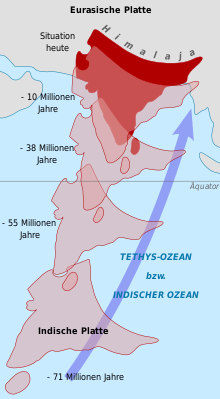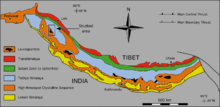Himalayas
![]()
The title of this article is ambiguous. For other meanings, see Himalaya (disambiguation).
f1
The Himalayas (also Himalayas) (Sanskrit: हिमालय, himālaya, from hima 'snow' and alaya "place, abode"; German pronounced [hiˈmaːlaɪ̯a] or [himaˈlaɪ̯a]) is a high mountain system in Asia. It is the highest mountain range on Earth and lies between the Indian subcontinent to the south and the Tibetan Plateau to the north. The boundaries to the west and east are not geologically based and are therefore drawn differently. The mountain range stretches for at least 2500 kilometers from Pakistan to the India-China border area in Arunachal Pradesh and reaches a width of up to 330 kilometers. The Himalayas are home to ten of the fourteen mountains on earth whose peaks are more than 8000 metres high ("eight-thousanders"), including Mount Everest, the highest mountain on earth at 8848 metres above sea level. With its southern location as well as the Tibetan plateau rising in the back of the Himalayas as an extensive highland, the Himalayas exert a great influence on the climate of South and Southeast Asia. Thus, the Indian summer monsoon is first produced by Ferrel's pressure formations in western India and Tibet, which are thermally induced in summer. Stowed at the main elevation of the Himalayas, some of the rainiest places on earth are located here, as well as the headwaters of all the major river systems of South Asia.
From a geological perspective, the Himalayas are part of a larger orogen - sometimes called the Hindu Kush-Karakoram-Himalayan Range - and in turn part of the largest mass uplift on Earth, known as High Asia or High mountain Asia.
Together with the Afghan highlands, Tibet, the Hengduan Shan in southwest China, the Arakan-Joma Mountains of Myanmar and the mountain foothills in Southeast Asia, the Hindu Kush-Himalayan region is formed, which was established by the riparian states as a transboundary greater region from a developmental and ecological perspective. (The abbreviation HKH mostly stands for the Greater Region, but is also used for the aforementioned Orogen!).
Outline
The High Himalaya in the proper sense are the mountain ranges, up to more than 8000 m high, which extend between the hill zones of the Ganges lowlands and the longitudinal furrow of the headwaters of the Indus and Brahmaputra (Tsangpo: Mazang/Damqog/Mǎquán and Yarlung/Yǎlǔ Zàngbù, respectively). To the north, the High Himalaya is separated by the Indus-Brahmaputra line from the Transhimalayan range (consisting of Gangdisê and Nyainqêntanglha), the fringe mountains of the Tibetan Plateau. The Himalayas reach their greatest heights in the north. The southern foothills of the Himalaya, which accompany it along its entire length, are called Siwaliks (also Churia or Margalla Hills). They are separated from the main ranges by the zones of the Inner Terai. To the south, these strike out in the Bhabhar and Terai belts. In addition, the chains of the Southern Himalaya, which only reach heights comparable to the Alps, are distinguished from the High Himalaya as the Front Himalaya (Lesser Himalaya "Little Himalaya").

enlarge and show information about the picture
![]()
Panorama of the Himalayas taken by an astronaut on board the International Space Station (ISS)
serves for image positioning, please do not remove
Geology
The Himalayas are the largest currently existing mountain range on earth. The mountain ranges tectonically connected with it, such as the Karakorum Mountains, have peaks of over 8000 meters high. They form part of the alpine mountain belt and are among the youngest high mountains on earth.
The Himalayas are a folded mountain range formed as a result of the plate collision of India with Eurasia. When the Indian landmass broke away from Gondwana about 200 million years ago, the Tethys Ocean lay between the Indian and Eurasian landmasses. The Indian drifted northward at a rate of about 9 meters per century, covering about 6400 kilometers, and rammed into the Eurasian plate about 40 to 50 million years ago. The collision slowed the rate of northward drift by half to about 5 centimeters per year and is considered the beginning of the rapid uplift of the Himalayas. The drift continues to this day and is so strong that the Himalayas are rising more than a centimeter per year. This is equivalent to a height increase of 10 kilometers in a million years. Since the collision, India has pushed itself another 2000 kilometers into Asia. This process has resulted in strong earthquakes, displacements and folding, the effects of which are noticeable far into China and Southeast Asia. The Nanga Parbat area of Pakistan has been uplifted more than 10 kilometers in less than 10 million years. Today's rates of uplift of the Himalayas are still remarkable. Even severe erosion could not keep pace with this. Nevertheless, the southern slope of the Himalayas is surrounded by large alluvial cones with fluvial deposits (molasse); these form the Siwaliks.
Although the Himalayas are the highest elevation on the Earth's surface, they are not the furthest place on the Earth's surface from the center of the Earth.

northward movement of the Indian Plate

Tectonic structure of the Himalayan system
Questions and Answers
Q: Where are the Himalayas located?
A: The Himalayas are a mountain range in South Asia. They run through Jammu and Kashmir, Himachal Pradesh, Uttarakhand, Sikkim and Arunachal Pradesh states in India, Nepal, and Bhutan. The west end is in Pakistan and the east end is in the south of Tibet.
Q: What is the highest mountain peak in the world?
A: Mount Everest is the highest mountain on Earth, at 8,849 meters.
Q: How many of the fifteen highest mountains peaks are located in the Nepali Himalayas?
A: Nine of the fifteen highest mountain peaks in the World are located in the Nepali Himalayas.
Q: What does "Himalaya" mean?
A: The word "Himalaya" means House of Snow in Sanskrit, an old Indian language.
Q: How has this mountain range influenced climate patterns?
A: The Himalayas have greatly influenced climate patterns by blocking extremely cold winter winds from Central Asia from entering Subcontinent and forcing Bay of Bengal Monsoon branch to shed its moisture along NE and Northern Indian States, Bhutan, Nepal and Bangladesh.
Q: What lies north of this mountain range?
A: North of the Himalayas is the Tibetan Plateau which is often referred to as “the roof of the world”.
Q: Why is it called “the roof of world”?
A: It's called “the roof of world” because it's very high up but also very dry due to acting as a gigantic rain shadow that forces rain to fall on south side instead.
Search within the encyclopedia